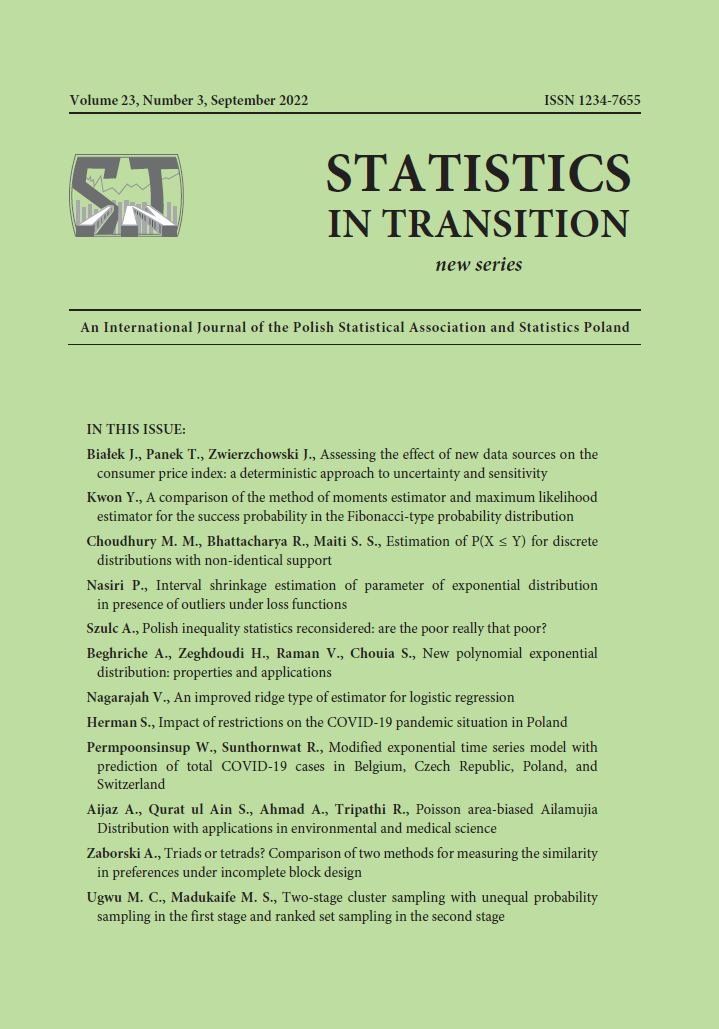ARTICLE
ABSTRACT
In this research work we introduce a new sampling design, namely a two-stage cluster sampling, where probability proportional to size with replacement is used in the first stage unit and ranked set sampling in the second in order to address the issue of marked variability in the sizes of population units concerned with first stage sampling. We obtained an unbiased estimator of the population mean and total, as well as the variance of the mean estimator. We calculated the relative efficiency of the new sampling design to the two-stage cluster sampling with simple random sampling in the first stage and ranked set sampling in the second stage. The results demonstrated that the new sampling design is more efficient than the competing design when a significant variation is observed in the first stage units.
KEYWORDS
cluster sampling, population mean estimator, probability proportional to size sampling, ranked set sampling, relative efficiency
REFERENCES
Al-Omari A. I., Bouza C. N., (2014). Review of Ranked Set Sampling: Modifications and Applications. Revista Investigacion Operacional, 35(3), pp. 215–240.
Chen Z., Bai Z., Sinha B. K., (2003). Ranked Set Sampling: Theory and Applications. Springer, New York.
Damon, V., (2018). Advantages and disadvantages of multistage sampling. https://classroom.synonym.com/advantages-disadvantages-multistage-sampling- 8544049.html
Dell, T. R., Clutter, J. I., (1972). Ranked set sampling theory with order statistics background. Biometrics, 28, pp. 545–553.
Dilip, N. C., (2015). Two-stage sampling design for estimation of total fertility rate: with an illustration for slum dweller married woman. Electronic Journal of Applied statistical Analysis, 8(1), pp. 112–121.
Fears, T. R., Gail, M. H., (2000). Analysis of a two-stage case-control study with cluster sampling of controls: Application to Nonmelanoma skin cancer. Biometrics, 56(1), pp. 190–198.
Galway, L. P., Bell, N., Shatari, S. AE. Al., Hagopian, A., Burnham, G., Flaxman, A., Weiss, W. M., Rajaratnam, J. and Takaro, T. K., (2012). A two-stage cluster sampling method using gridded population data, a GIS and Google Earth TM imagery in population-based mortality survey in Iraq. International Journal of Health Geographics, 11(12), pp. 1–9.
Halls, L. S., Dell, T. R., (1966). Trial of ranked set sampling for forage yields. Forest Science, 12(1), pp. 22–26.
Hansen, M. H., Hurwitz, W. N., (1943). On the theory of sampling from a finite population. Annals of Mathematical Statistics, 14, pp. 333–362.
Horney, J. J., Dickinson, M., Hsai, J., Williams, A. and Zotti, M., (2010). Two-stage cluster sampling with referral: Improving the efficiency of estimating unmet needs among pregnant and postpartum women after flooding in Northwest Georgia. Remote Sensing of Environment, 113(6), pp. 1236–1249.
Innocenti, F., Candel, M. J. J. M., Tan, F. E. S. and van Breukelen, G. J. P., (2019). Relative efficiencies of two-stage sampling schemes for mean estimation in multilevel populations when cluster size is informative. Statistics in Medicine, 38(10), pp. 1817–1834.
Innocenti, F., Candel, M. J. J. M., Tan, F. E. S. and van Breukelen, G. J. P., (2021). Optimal two-stage sampling for mean estimation in multilevel populations when cluster size is informative. Statistical Methods in Medical Research, 30(2), pp. 357–375.
McIntyre, G. A., (1952). A method of unbiased selective sampling, using ranked sets. Australian Journal of Agricultural Research, 3, pp. 385–390.
Nematollahi, N., Salehi, M. M. and Saba, A. R., (2008). Two-stage cluster sampling with ranked set sampling in the secondary sampling frame. Communications in Statistics–Theory and methods, 37(15), pp. 2404–2415.
Okafor, F. C., (2002). Sample Survey Theory with Application. Afro-Orbis Publications Ltd. Nsukka.
Ozturk, O., (2019). Two-stage cluster samples with ranked set sampling designs. Annals of the Institute of Statistical Mathematics, 71, pp. 63–91.
Patil, G. P., (2002). Ranked set sampling. Encyclopedia of Environmetrics, 3, pp. 1684– 1690.
Phillips, A. E., Boily, M. C., Lowndes, C. M., Garnett, G. P., Gurav, K., Ramesh, B. M., Anthony, J., Watts, R., Moses, S. and Alary, M., (2008). Sexual identity and its contribution to MSM risk behaviour in Bangaluru (Bangalore) India: The results of a two-stage cluster sampling survey. Journal of LGBT Health Research, 4, pp. 111– 126.
Shahbaz, M. Q., Hanif, M., (2010). Some developments in unequal probability sampling: selection procedures and estimators. Lap Lambert Academic Publishing, GmbH & Co. KG, Deutschland.
Stehman, S. V., Wichham, J. D., Fattorini, L., Wade, T. D., Baffetta, F. and Smith, J. H., (2009). Estimating accuracy of land-cover composition from two-stage cluster sampling. Remote Sensing of Environment, 113(6), pp. 1236–1249.
Stokes, S. L., (1980). Estimation of variance using judgment ordered ranked set samples. Biometrics, 36, pp. 35–42.
Takahasi, K., Wakimoto, K., (1968). On unbiased estimates of the population mean based on the sample stratified by means of ordering. Annals of the Institute of Statistical Mathematics, 21, pp. 249–255.
